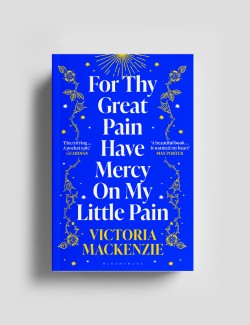
Image: Hardback cover of For Thy Great Pain Have Mercy On My Little Pain
My debut novel, For Thy Great Pain Have Mercy On My Little Pain, explores the lives of two medieval women, Julian of Norwich and Margery Kempe. It was published in 2023 by Bloomsbury and won the First Book Award at Scotland’s National Book Awards. It was recently broadcast on Radio 4 and has also been longlisted for the Walter Scott Prize for Historical Fiction.
I wrote the novel in 2020, during the early Covid-19 lockdowns, when the world had become unfamiliar and uncertain. I sat at home in my quiet Scottish village, with two extraordinary medieval women’s books for company, and wrote a short novel to please only myself. I’ve been overwhelmed by the response to the novel and delighted that it has even brought new readers to the works of my two female protagonists.
Since publication, one of the questions I’ve been asked most often is – why these two women? In truth, when I first had the idea for the novel, I only intended to write about Julian. Ever since I was a teenager I’ve loved books about nuns (‘nun-fiction’TM). Not the hard-faced cruel nuns that feature in much Irish fiction, but the ‘truly dedicated, give up everything for Christ, ask big questions about life’ kind of nuns. I love Black Narcissus and In This House of Brede by Rumer Godden and adore Ron Hansen’s novel, Exiles, which imagines the stories of the five Franciscan nuns who drowned when the boat, The Deutschland, sank in 1875, and who inspired Gerard Manley Hopkin’s remarkable poem ‘The Wreck of the Deutschland’. I’m not religious myself, but I’ve always been interested in anyone who lives their life in accordance with a larger framework – whether that’s religious, philosophical, ethical, political or whatever else.
Julian of Norwich had floated around the edges of my consciousness for some years, and I’ve really no idea when I first came across her or her book, Revelations of Divine Love. But in 2019 I started to think about her as a potential novel subject. It was her life as an anchoress that intrigued me (I use that word, rather than ‘anchorite’, as it’s the word Julian would most likely have used herself). An anchoress was someone who dedicated their life to prayer and contemplation like a nun, but they were also usually enclosed in a single room (or ‘cell’) and couldn’t leave this room on pain of excommunication; anchoresses were expected to die in their cells and some were even buried in them. Julian’s cell was attached to St Julian’s Church in Norwich, from which she took her name. She was probably about forty when she entered it, and she died thirty or so years later. But why take a vow of ‘anchorage’, and give up everything to live in a single room? What sort of life experience drives someone to make that choice? What sort of person can actually manage to live in one room for thirty years?
As a fiction writer, I get to imagine the answers to such questions. I don’t start writing knowing what I’m going to say; my writing process is exploratory, intuitive, and I try to discover meaning along the way. When writing about Julian’s life, I asked myself lots of questions: What was it like physically in that room? I tried to imagine the inability to stretch her legs and get fresh air. What it was like mentally? How would enclosure change her ideas about the world, and maybe even her sense of self?
Julian’s book, Revelations of Divine Love, is the first known book in English by a woman, andis focused on the sixteen ‘shewings’ or visions of Christ that Julian experienced aged thirty, about ten years before she entered her anchoress cell. It’s a deeply contemplative, profoundly beautiful text which uses many rhetorical devices, such as the rule of three, alliteration, repetition and metaphor; Revelations of Divine Love is a book of fine literature as well as sophisticated theology. As a person, Julian comes across as calm, learned, wise, but we don’t really know anything about her: we don’t know if she married or had children, we don’t know if she was a nun or layperson before she became an anchoress, and we don’t even her real name.
I imagined Julian in her cell, looking out of her window and tracing the passing of the days and months through the unfurling of leaves on a tree outside her window, the arrival of swallows, and the scent of freshly cut hay on the breeze. For me, there’s something a little misty and ethereal about the term ‘mystic’, so I wanted to create an earthy, flesh and blood character for Julian. Once she enters her cell, I didn’t shy away from thinking about her as someone with bodily needs, as well as emotional frailties. I wanted that calm, contemplative voice that shines through in Revelations of Divine Love to be hard won, so in the early months of her life as an anchoress, I show her experiencing feelings of frustration and restlessness, and an inability to concentrate – feelings that many of us experienced in lockdown too. It’s only over time that she gains control over her thoughts, through prayer and contemplation, through writing her book, and by participating (through another small window in her cell) in church services.
Once I began researching Julian’s life and writings, I inevitably stumbled across the figure of Margery Kempe. Oh Margery! Many people find her aggravating and I get it, I do. But I of fell in love with her. I read her autobiography, The Book of Margery Kempe, which she dictated to several scribes towards the end of her life (whereas Julian probably wrote her book herself), and was astonished. How could someone feel so real, so vivid, when they had lived more than 600 years ago? Yes, she’s vain and boastful, concerned with fashion and constantly thinks about what her neighbours think of her, but she’s also vulnerable, uncertain of herself and in need of some good advice. She claims to have regular conversations with Christ and these holy meetings sometimes even take a rather carnal turn. Many in her community disbelieve Margery, saying they are the work of the devil or Margery’s own imaginings. Yet Margery’s book is the first known autobiography in English by a man or a woman and so, like Julian, she’s an incredibly important figure in the history of writing. Her book is also a rare example of written evidence about the life of an ordinary woman – Margery was a merchant’s wife and mother to fourteen children, not a noblewoman or a nun, and her book gives us a fantastic insight into the life of middle-class medieval life from a female perspective.
The parallels between Julian and Margery – both women who lived in Norfolk in the late fourteenth and early fifteenth-centuries, who both had holy visions, and who both wrote the earliest known books in English by women – were striking and I decided to structure the book as two interweaving first person monologues with each woman addressing the reader directly, telling the stories of their lives. I switch back and forth between the two voices, cutting away for pathos, for humour, sometimes to show the parallels in their lives, sometimes to highlight the differences. I used their own books to shape their voices – Margery is boastful, energetic, a bit chaotic; Julian is calm, observant, thoughtful. But I was always aware that these were two fictional characters of my own creation, and it was essential that I felt able to ‘own’ them and to shape the material to the demands of fiction. I did plenty of research, of course – social history about the lives of medieval women, the Black Death, the lives of anchoresses, and life in medieval Norfolk. But as a fiction writer, whilst I try not to deliberately introduce any anachronisms or factual inaccuracies, what matters to me is a sense of emotional truth and a compelling narrative. I make no claim to be a scholar of medieval English either – I read Elizabeth Spearing’s translation of Revelations, and Barry Windeatt’s translation of Margery Kempe. A novel is not a work of original scholarship, but an empathetic leap into the lives of others.
Reading The Book of Margery Kempe I discovered that Margery had actually visited Julian in her anchoress cell in Norwich, to ask the anchoress for ‘wise counsel’ regarding Margery’s holy visions. What a joy for an author! I immediately knew that this meeting would be the climax of the book. I bring the two women together and imagine what they might have said to one another – these two contemporaries, with so many parallels yet living such different lives and having such different personalities.
I didn’t want Margery to be simply a comic foil to Julian’s wisdom – I wanted to develop a vulnerable side to her. For me, one of the most important lines in the novel is when Margery comes to Julian’s cell, and Julian thinks to herself:
Her voice swanned and preened and boasted, yet there was another note to her song. Margery Kempe was the loneliest woman I had ever met.
I also wanted Julian to recognise Margery’s bravery in sharing her holy visions. Julian did not share her visions with many people for fear of being accused of heresy. This was a very real fear, since the punishment for heresy at the time was to be burnt at the stake. But Margery told anyone who’d listen, even standing in the street in her home town of Bishop’s Lynn (now King’s Lynn) to speak about them – risking accusations of preaching which, as a woman, was also in breach of the church’s teachings.
Although Julian wrote about her visions, it’s not known if Julian showed her book to anyone in her lifetime, nor how it left her cell, so in I imagined a scenario in which her book entered the world. For Thy Great Pain is a novel about medieval women’s lives, their frustrations and joys, but it’s also about the agency that writing can give to a person, as well as the way that the written word can change lives. As I have Margery say, ‘if there are words, there is no death’.

Image: Paperback cover of For Thy Great Pain Have Mercy On My Little Pain
